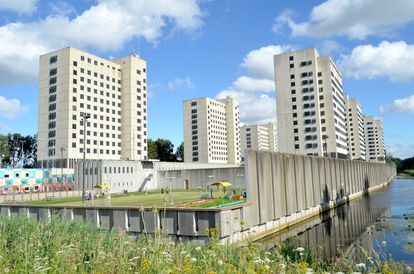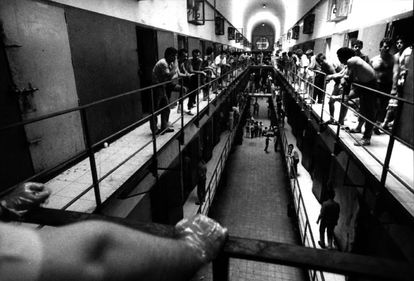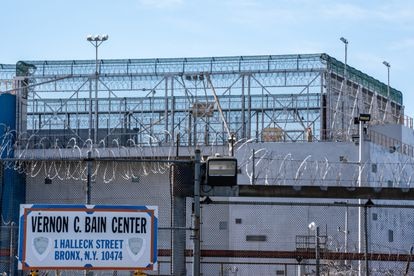Prisons are a symbol of the power of the modern state over its citizens, a privileged vantage point from which to witness the social and cultural transformations of the last three centuries, an instrument in which the disciplinary and control procedures that will later be applied in all spheres are tested, the object of philosophical speculation, the focus of heated political debates and the setting of innumerable fictions. But before that (before contemplating its transformation into a business or an industry, too), prisons are the home of their inmate population; men and women who adapt as best they can to their lack of freedom and the conditions in which they experience it.
Prisons are extremely complex spaces that seem to concentrate and contain all the tensions and contradictions of the societies that build them. To name this phenomenon, that is, to refer to certain places that reflect and are necessary for social order but at the same time are uncomfortable or subversive, philosopher Michel Foucault coined the term “heterotopia” in 1967. Since then, this concept, usually illustrated with a prison, has been fundamental to the work of many contemporary architects. It is just one more example: the reflection on prison, since its modern conception as an alternative to torture at the end of the 18th century, has gone beyond the limits of criminal law to also mix with the practice of architecture and philosophy. However, in spite of all the literature, beyond its almost totemic presence at the end of certain criminal proceedings, unless it is through a very close experience, we know little about what happens inside the penitentiary centers that we pass by when we travel, so distant from the city centers.
Contradictions
“Nothing in prison is really trivial. […] The minor inconveniences of life take on enormous significance in any closed institutions,” wrote British ombudsman Stephan Shaw. Any detail matters when you are forced to inhabit the same closed spaces for months, something most of us discovered in 2020 when the Covid-19 pandemic fueled the discussion about domestic spaces.
Architect and academic Elena M. Millana studies “the tensions and contradictions of domesticity through the homes of those who did not have the family as a reference, considering forms of collective life inhabited by single people, but within a community.” In her research, Millana has come across several cases like the Penitentiary Institution Amsterdam Over-Amstel, commonly known as Bijlmerbajes, which was built between 1972 and 1978 with a barless design, very similar to that of the surrounding homes. “That sparked widespread rejection,” explains the architect. “And I wonder: Why are people offended if prisons look like their homes? Must prisoners live in worse places? Or are they outraged because then they perceive their homes as prisons?”

When contemporary architects project a prison, they face, in addition to controversy, a series of paradoxes. Some have to do with the above: a building with two complex, difficult-to-balance functions (resocialization and retention) serves, at the same time, as a home for hundreds of people and a workplace for dozens of them. However, as Roger Paez, author of the project for the Mas d’Enric Penitentiary Center in Spain, points out in Critical Prison Design (2014), there are also conceptual contradictions. The English reformers of the 18th and 19th centuries were convinced that the shape of a space (developed through architecture or urban planning) would be able to influence the behavior of its users, while more contemporary authors, such as sociologist Manuel Castells, state that “the space is always the reflection of a society” and it does not affect it much.
Thus, when architects approach the project of a prison, they find, according to Paez, “a programmatic need for confinement together with an ethical need for freedom.” They must make “life emerge” within the prison walls, while being aware of their own limitations and biases, because the role of architecture as an agent of social transformation has been questioned for decades. Millana explains it like this: “Architects today don’t believe that architecture can transform society. At least not like they did in other historical periods like that of the avant-garde movements. It is an accepted loss in the postmodernity under whose influence we are still.”
Foucault addressed many of these issues in Discipline and Punish (1975). In this essay, the philosopher examines the social changes that took place after the adoption of modern penal codes, in which physical punishment (often public torture) was replaced, for most criminals, by prison. As Foucault points out, these new forms of punishment, created for reintegration, would act “on the conscience or the soul of the condemned, not on their bodies.” And yet, the execution would still require a physical space because, as the Frenchman also writes, “discipline proceeds from the distribution of individuals in space.”
From the beginning, the same thinkers who sought to rationalize and sanitize the punishment tried to find the best of these spatial distributions. Thus, fully immersed in the field of architecture, philosopher Jeremy Bentham published in 1780 the basis of a prison model that is still relevant today: the panopticon. The panopticon building, built radially, would allow a guard protected by a central tower to control all the cells around him, built on as many levels as necessary. Thus, a single guard could be in charge of a multitude of prisoners that would never know when they are being watched: an uncertainty equivalent to a perpetual surveillance system. Bentham also considered the need for other watchmen in charge of verifying that the first one fulfilled his duties, thus establishing a potentially infinite chain of responsibility.
With all its philosophical, and even metaphysical implications, since Foucault retook it, the panopticon has served to explain the functioning of practically any of the institutions of what he described as “a disciplinary society”: schools, hospitals, nursing homes, private developments and more. And today, in the era of “surveillance capitalism,” it is one of the most cited models in texts about social networks or data traffic.

The neoliberal prison
Every prison is a reflection of the society that built it and, given that in recent years neoliberalism has extended the logic of market, contract, and profit to all kinds of institutions and services (education and health, for example), the penitentiary institutions have also undergone a transformation.
The privatization of prisons is common in countries like the United Kingdom (with approximately 15% of its prisoners in private centers) and the United States (with 8% of its inmates in them). A few months ago, the Bibby Stockholm barge, a floating prison owned by a marine operations company, caused a stir after the British government locked up around 500 migrants in it. The episode, reminiscent of the times before the penal reform of the 18th century, when old, dilapidated warships were used to hold prisoners, is not the first case of a floating prison in recent years: New York City has been incarcerating convicts in a 625-foot-long barge for 30 years. The Vernon C. Bain Correctional Center might look like just another ship on the docks of the East River, but it is actually home to more than 800 prisoners.
If for decades the efforts of lawyers, architects and philosophers to improve prison conditions had met with resistance from the most punitive social sectors, today they seem to be colliding with the demand to reduce public spending at all costs. And so, the prison has gone from being a symbol of the magnanimity of modern states to being another gear in their austerity policies.

Sign up for our weekly newsletter to get more English-language news coverage from EL PAÍS USA Edition
This post was originally published on this site be sure to check out more of their content.








